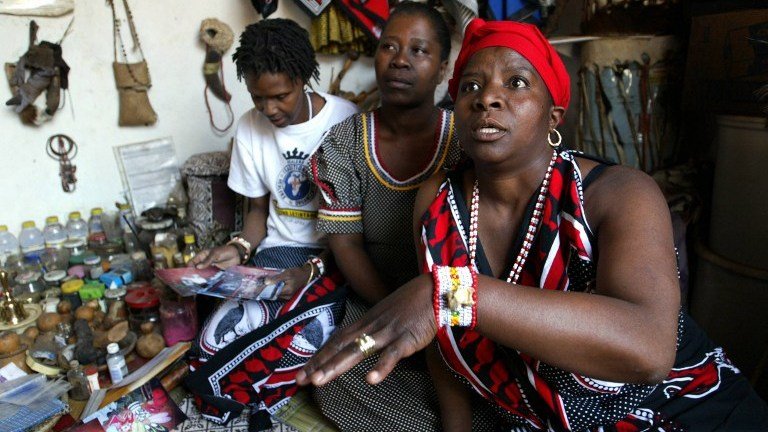Today I would like to focus on Sangomas and inyangas which are the two main types of indigenous or traditional healers in Eswatini.
Sangoma
Sangomas are spiritual healers and are often women. They are people who diagnose illness.
People often visit the sangoma in family groups but sometimes they go alone. The reason for this is that the sangoma does not see people as individual’s but rather sees them as part of a community.
People’s sickness is often related to their relationship with other people. People can also become sick because they are having problems at home or work. This is the reason why sangomas look at the environment that people live and work in to find reasons for their illness.
Sangomas also look at social factors that could make someone ill, as well as the physical symptoms. This way of looking at illness referred is called holistic. When sangomas diagnose illness, they listen to their ancestors. When sangomas are listening to their ancestors, they may put on special clothes and beads.
They may use dancing, singing and drumming during a healing ritual. The ancestors speak through them.
A sangoma asks the individual and family many questions. The sangoma may also throw the bones. The ‘bones’ are often real bones of sacrificed animals. They can also be stones, shells or other objects.
Each ‘bone’ has a meaning. They represent part of the patient’s life. For example, one bone could represent a person’s mother. Another bone could represent the person’s physical health, or financial situation.
You throw the bones and the ancestors tell you exactly what to say.
Inyanga
| This is a healer who uses herbs and medicines to make people better. | |
| Muti | A traditional word for medicine. |
| Toxic | This is another word for ‘poisonous’. |
| Dose | The dose is the amount of medicine which must be taken. |
| Endangered | There are very few of these things left alive. |
| Rituals | These are customs or ways of doing things, for example, a wedding ceremony is a ritual. |
‘Inyanga’ means ‘man of the trees’ in siswati. Inyangas are healers that make medicines from herbs, roots and bark. Ground up rocks, animal horns and bones can also be used in the making of their medicine.
After a patient has been diagnosed by an inyanga they then go into bush to find the specific plants necessary for healing. Herbs and roots that are used for healing, sometimes called ‘muti’, can be bought at markets as well as directly from an inyanga.
Inyangas train for a very long time. It is important that they know the powers of the different herbs. These are powerful medicines that can be toxic if the wrong dose is given.
The Bitter Aloe (inhlaba in Siswati) is used as a traditional medicine. The leaves or roots are boiled in water. The liquid is used for the treatment of eczema, stress and eye infection. The sap can be applied to burns and bruises.
Below, is a table showing some everyday Swazi’s plants which were first used in traditional medicine. Their healing powers have been researched by scientists and they are now used in western medicines as well.
| Name of plant | What is this plant used for? | Scientific proof of healing agents |
|---|---|---|
| Pennywort/ varkoortjies | It is used to treat wounds and fevers. It is also used to treat acne and allergies. | Yes |
| Coral Tree/ umsinsi | The bark is used to treat toothache and arthritis. It is also used on swellings and wounds. | Yes |
| Madagascar periwinkle/sisushlungu | The roots are used to treat diabetes and rheumatism. Liquid from the leaf is used in chemotherapy to treat several types of cancer. | Yes |
| Kouterie/imphewula | The warmed leaf is used for earache and inflammation. It is also used to soften and remove warts and corns. | Yes |
| Hoodia/bitterghaap | The stems are dried and used to stop people wanting to eat. It is also used for indigestion and stomach ache. | Yes |
How people are trained to become a sangoma or an inyanga
Not everyone can become a sangoma or inyanga. Healers believe that they are called by the ancestors to take on this important and respected position in society. Traditional healers speak of a sudden unexplained illness they had or they heard voices and saw visions.
Many also talk about very bad headaches that would not go away. Their illnesses would not go away until they listened to the ancestors and went to train as a sangoma or an inyanga.
Adapted from: Called to Heal, S. Campbell
(Zebra Press, 1998)
Inyangas are called in a different way. In the old days, an inyanga would look at his family and identify the child who showed the most interest in medicines. Inyangas are sometimes identified through dreams. This person then became an assistant to an inyanga sometimes called as Nyankwaphe. They were taught which plants and herbs to use for healing.
Training to be a sangoma or an inyanga is very hard work. It is both physically and mentally challenging. Some of the things that trainees have to do include the following:
- They have to eat certain foods.
- They have to do exactly as their trainers tell them.
- They have to follow a very strict set of cleansing rituals.
This was my last write up on Eswatini Daily News as Laurence Lukhele and the founder of this publication. Hope you keep on sharing content here and enjoy the upcoming write ups. Most of the write up was sourced from the net and some personal knowledge.



1 comment
[…] Read More: Indigenous medicine and traditional healing […]